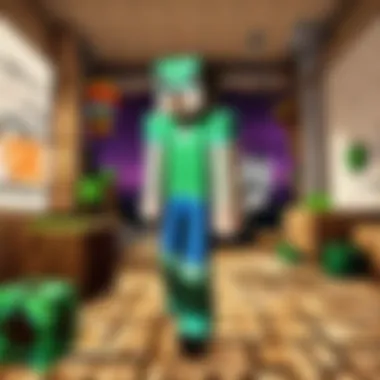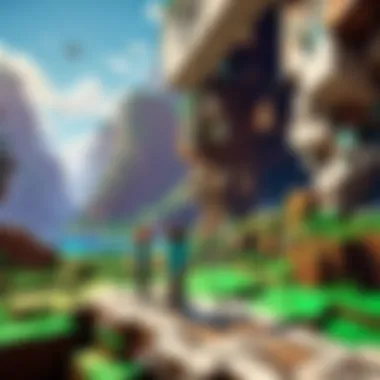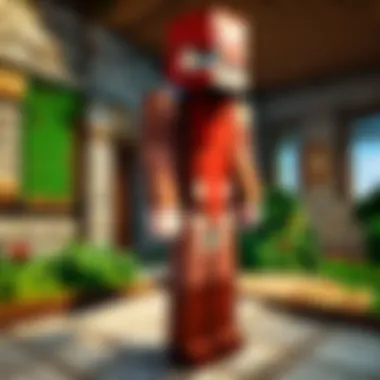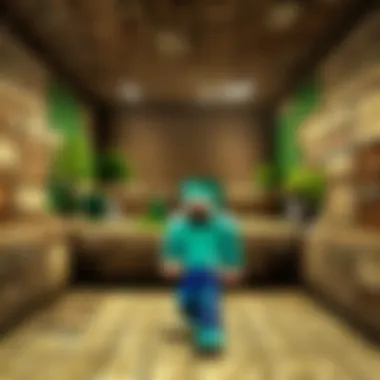Unlocking Free Educational Resources in Minecraft


Intro
Educational Minecraft is becoming more popular among teachers and parents. The game can transform learning into a fun experience. This article explores how to access free resources to use Minecraft for educational purposes. It highlights what makes Minecraft valuable in education, including its creative and interactive nature.
Additionally, it provides practical tips for both teachers and parents to implement Minecraft as part of their learning strategies. The insights offered here aim at maximizing educational potential without a financial commitment.
Understanding Minecraft as an Educational Tool
Minecraft has emerged as a versatile educational tool that captivates learners of various ages. This game goes beyond entertainment; it offers a platform for creativity, critical thinking, and collaborative learning. Through its block-based environment, players can engage in designing structures, solving complex problems, and collaborating with peers, which can enhance both cognitive and social skills.
The flexibility of Minecraft allows educators to easily incorporate it into diverse learning objectives. From mathematics to history, the game's adaptable nature supports various subjects. As players navigate the virtual world, they encounter challenges that promote strategic thinking and resource management. This active engagement can help solidify concepts learned in traditional classrooms.
Moreover, Minecraft's vast community encourages sharing knowledge and resources. Educators can leverage user-generated content to create enriched learning experiences. Also, the game promotes digital literacy by encouraging students to navigate and utilize technology effectively. Thus, understanding how Minecraft serves as an educational tool can significantly impact teaching methodologies and learning strategies.
The Evolution of Minecraft in Education
Initially released as a sandbox game, Minecraft has gradually morphed into a powerful educational resource. Schools began to recognize its potential when educators noticed the game's capability to enhance engagement compared to traditional teaching methods. Over the years, various versions have been tailored specifically for educational use, most notably the Minecraft Education Edition.
This version tailors features to facilitate learning, including in-game coding and collaborative projects. Many institutions see Minecraft not just as a game but as a platform where students can explore, create, and learn in real-time. As a result, numerous lesson plans have been developed, showing educators how to utilize this tool effectively.
Minecraft's growth as an educational tool traces its roots in user feedback and community involvement. Teachers consistently contribute ideas, honing the game's application in educational settings. This organic evolution has fostered a robust learning ecosystem that extends far beyond the game.
Key Learning Outcomes Associated with Minecraft
Utilizing Minecraft in educational contexts yields several significant learning outcomes. One major benefit is enhanced creativity. Students are encouraged to think outside the box while designing and building within the game. This creative approach can lead to innovative problem-solving skills that are valuable in any academic discipline.
Another important outcome is improved collaboration skills. Multiplayer features allow students to work on projects together, requiring effective communication and teamwork. Such interaction reflects real-world scenarios where collaborative effort is essential.
- Cognitive Skills: Players develop critical thinking and decision-making skills as they navigate challenges.
- Technical Proficiency: Handling the game's mechanics promotes familiarity with technology, crucial in today's digital world.
- Motivation and Engagement: The interactive nature of gameplay keeps students interested and eager to learn.
In summary, the outcomes provided by utilizing Minecraft as an educational tool can profoundly influence learner engagement and achievement. The game’s unique structure fosters an environment conducive to exploring complex ideas in a fun and interactive way.
"Minecraft is not just a game; it's a vehicle for hands-on learning that engages students in meaningful ways."
Integrating these aspects into educational frameworks can enrich the learning experience and set the stage for future academic successes.
Free Educational Resources Available for Minecraft
The availability of free educational resources for Minecraft is crucial in making the game accessible for both educators and students. The concept of utilizing Minecraft as a teaching aid is becoming more popular, but often barriers arise in terms of financial resources. By focusing on cost-free options, this article illuminates opportunities for creative and engaging learning experiences without requiring financial investment. Not only does this open doors for underfunded schools, but it also empowers parents and caregivers to integrate educational tools into home learning environments. Ultimately, these resources serve to enhance learning outcomes, fostering collaboration and innovation in various educational settings.
Official Minecraft Education Edition Resources
The Minecraft Education Edition is specifically designed to facilitate teaching and learning. This version offers a myriad of resources that educators can access at no cost. Teachers can find lesson plans, classroom activities, and even assessment tools. The official website frequently updates resources to keep content fresh and relevant.


Some key elements include:
- Lesson Plans: Structured guides for subjects like math, science, and history, aimed at different grade levels.
- Classroom Tutorials: Step-by-step instructions to help teachers integrate Minecraft into their lessons effectively.
- Community Challenges: Engaging challenges that encourage students to think critically and work together.
The official resources are rich and comprehensive, ensuring that educators have everything they need to integrate Minecraft into their teaching methodologies.
User-Generated Content and Community Contributions
The Minecraft community is vast and diverse, with many users contributing educational content that can be accessed for free. This includes everything from custom maps geared towards teaching history to mods that introduce new learning elements. The importance of these community-generated resources lies in their creativity and adaptability. Educators can tap into a wealth of ideas that often reflect real-world contexts.
For example, many users on platforms like Reddit share their experiences and success stories with educational Minecraft, fostering an environment of support. Resources to consider include:
- Maps for Learning: Custom maps tailored for specific subjects.
- Instructional Videos: Tutorials on using Minecraft for educational purposes.
- Forums and Discussion Groups: Spaces for sharing resources, asking questions, and collaborating on projects.
These contributions often reflect the latest trends in education, helping to keep the learning experience dynamic and engaging.
Online Platforms Offering Free Minecraft Courses
Several online platforms provide free courses that focus on utilizing Minecraft for educational purposes. These resources cover a range of topics and are tailored for various skill levels. Some notable ones include:
- Code.org: Offers free courses that teach coding concepts using Minecraft.
- YouTube: Many educators and Minecraft enthusiasts create tutorial videos about using Minecraft as a learning tool.
- Edmodo: This social learning platform provides access to Minecraft-related educational materials, discussions, and collaborations.
Free courses can be essential in guiding educators and parents through effectively implementing Minecraft in educational contexts. They offer structured frameworks to ensure that the use of Minecraft is purposeful and aligned with learning objectives.
Access to free educational resources for Minecraft democratizes learning and provides opportunities for creativity in ways that are not usually possible.
Practical Applications of Educational Minecraft
Educational Minecraft offers a unique platform for hands-on learning experiences. It transforms traditional learning methods by encouraging exploration and creativity through gameplay. This section elaborates on the importance of integrating Minecraft into educational settings, focusing on its applications for teachers and parents.
Integrating Minecraft into School Curricula
Integrating Minecraft into school curricula can revitalize the learning environment. Teachers can utilize the game to engage students in various subjects such as mathematics, science, history, and art. For example, students can create historical landmarks in Minecraft, reinforcing their understanding of architectural styles and historical contexts.
Practical applications include collaborative projects where students work together to solve complex problems. This encourages teamwork and improves social skills. Additionally, teachers can design specific challenges that align with educational standards, allowing students to practice critical thinking and problem-solving skills in a virtual context.
Some specific elements to consider when integrating Minecraft into curricula are:
- Lesson Planning: Teachers should create clear objectives that correspond with in-game tasks.
- Assessment: Establish a method for evaluating student progress through their builds and participation.
- Resource Allocation: Ensure that students have access to necessary tools and a stable internet connection.
Parental Guidance on Minecraft Use for Learning
Parental involvement is crucial in guiding children's Minecraft use for educational purposes. Parents can facilitate a positive learning experience by engaging with their children during playtime. This involvement not only enhances learning but also boosts communication skills as they discuss in-game strategies and projects.


Parents should set clear boundaries on screen time while encouraging educational activities within the game. Suggested ways to achieve this include:
- Creating Learning Goals: Help children set educational objectives related to their Minecraft gameplay.
- Monitoring Progress: Regularly check in on their projects and discuss what they are learning.
- Encouraging Creativity: Motivate children to share their creations with family members or friends.
Advantages and Challenges of Using Minecraft in Education
Understanding both the advantages and challenges of using Minecraft as an educational tool is crucial for educators and parents alike. As an immersive environment, Minecraft offers unique benefits in learning, but also presents considerations that need addressing. By navigating through these aspects, learners of all ages can maximize their experience while minimizing potential pitfalls.
Benefits of Interactive Learning through Minecraft
Minecraft cultivates an engaging learning experience. It allows students to participate actively in various educational processes. Some benefits include:
- Creativity and Collaboration: Minecraft is designed as a sandbox game that promotes creativity. Students can collaborate on projects, enhancing their teamwork skills. This interactive environment encourages them to share ideas and work through challenges together.
- Problem-Solving Skills: The open-ended nature of Minecraft invites players to explore solutions. When faced with obstacles, learners must think critically and develop strategies to overcome them. Such experiences facilitate the growth of essential problem-solving skills.
- Experiential Learning: Students can learn through direct experience. Whether they are building historical landmarks or exploring ecosystems, learning is contextualized within the game. This form of learning supports retention and understanding of the material.
- Customization for Diverse Learners: Minecraft can cater to different learning styles. Visual learners can benefit from creating models, while auditory learners may prefer working on collaborative projects. This versatility allows educators to address the varied needs of their students effectively.
Potential Drawbacks and Considerations
Despite the numerous advantages, there are potential drawbacks and considerations that educators and parents must remain aware of:
- Distractions: The game’s social elements, such as chat and multiplayer features, can distract students from educational tasks. While social interaction can be beneficial, it can lead to off-topic discussions or disruptive behavior.
- Access to Resources: Not all students may have the same level of access to technology. Ensuring that all participants have the necessary resources is essential for equitable learning experiences. Disparities in access may lead to exclusion, which can affect overall engagement and success.
- Steep Learning Curve: Some students may find initial gameplay challenging. Learning the mechanics of Minecraft requires time, which might not always align with educational goals. Educators should consider providing proper instructions or guidance to ease this process.
- Balance with Traditional Learning: While Minecraft offers valuable interactive experiences, it should not completely replace traditional educational methods. Finding a balance ensures that students receive a well-rounded education that includes both innovative and conventional learning strategies.
"Interactive learning fosters creativity and critical thinking, essential skills for the future."
In summary, utilizing Minecraft as an educational tool presents significant advantages that can enhance student engagement and learning outcomes. However, it is crucial to recognize and address the challenges that arise. By carefully integrating Minecraft into educational settings, practitioners can leverage its benefits while navigating its limitations.
Building a Community of Learners within Minecraft
Building a community of learners within Minecraft offers significant advantages for players and educators. This digital playground provides a unique space for collaboration, creativity, and engagement, fostering a strong sense of community among users. With the ability to work together on projects and interact in real time, learners can exchange ideas, solve problems, and enhance their understanding of concepts in an immersive environment.
One of the main benefits of community learning in Minecraft is the encouragement it gives to teamwork. Players often rely on each other's strengths to complete tasks. Different individuals may bring unique skills to the table, such as building techniques or command block knowledge. This collaboration helps develop social skills and improve communication among students. They learn to appreciate diverse ideas and approaches, which can be beneficial in both educational settings and future workplaces.
Additionally, working together in this digital space promotes inclusivity. Students who may feel shy or disengaged in traditional classrooms can find their voice in Minecraft. The game allows them to express themselves creatively and bond over shared interests, making it an excellent tool for building a supportive learning community. By creating environments where every voice matters, educators can help cultivate a positive learning atmosphere.
However, there are considerations when fostering a community in Minecraft. Teachers and parents should monitor interactions to ensure a safe and respectful environment. Setting clear guidelines for communication and teamwork can help facilitate constructive engagement. Also, understanding the dynamics of multiplayer gaming is crucial, as it can sometimes lead to conflict. Addressing these issues promptly is essential to maintaining a healthy community.
Collaboration should also extend beyond just gameplay. Encouraging players to share their projects and creations can help solidify community bonds. With such discussions, student engagement can further thrive.
"Community learning in Minecraft is not just about building structures; it is about building relationships and understanding."
Collaborative Projects and Multiplayer Learning
Involving students in collaborative projects within Minecraft can enhance their learning experience. These projects may include building historical landmarks, creating scientific models, or even coding simple game mechanics using redstone. Working together on these endeavors helps students learn project management skills, as they need to communicate, delegate tasks, and meet deadlines. Moreover, collaborative learning encourages problem-solving. When faced with challenges, players must come together to brainstorm solutions, learning from one another in the process.
Multiplayer gaming also offers opportunities for peer review. Players can critique each other's work, providing constructive feedback and suggestions for improvement. This peer-to-peer interaction supports critical thinking and enhances creativity. As students learn to appreciate diverse perspectives, they become more adaptable and innovative in their approaches.


Showcasing Student Creations and Achievements
Highlighting student creations is vital in reinforcing a sense of achievement within the community. Allowing students to display their work fosters pride and inspires others to explore their creativity. This can be done through virtual showcases, where learners present their builds and explain their thought processes. In addition, educators can utilize platforms such as forums and social media, sharing these student projects with a broader audience.
These showcases not only validate the hard work students put into their projects, but they also encourage an ongoing dialogue about learning. When students discuss their achievements, they reinforce their understanding of the concepts learned. Furthermore, it creates opportunities for constructive feedback, leading to growth and further exploration.
Engaging the wider community through student project displays can strengthen not only the bond among learners but also celebrate the collective accomplishments of the Minecraft educational community. Through these initiatives, the cycle of sharing, learning, and growing continues to thrive.
Future Trends in Educational Gaming
The educational gaming sector is on the cusp of transformative growth. As digital technologies evolve, the significance of educational games, such as Minecraft, becomes ever more pronounced. This section analyzes how these trends not only shape current educational paradigms but also offer future opportunities for learners. The focus is on how innovations in game design and educational theory can enhance learning experiences.
Innovative Approaches to Learning through Games
Educational games are stepping beyond traditional methods of instruction. They incorporate immersive experiences that foster critical thinking and problem-solving skills. In the context of Minecraft, educators can utilize game mechanics to support curriculum goals. For example, tasks like constructing complex structures require mathematical reasoning, spatial awareness, and teamwork.
- Collaboration Tools: The integration of real-time collaboration tools in educational games allows students to work together, regardless of their geographical location. This encourages communication and teamwork, essential skills in today’s workforce.
- Adaptive Learning: Games are now being designed with adaptive learning components. They analyze player strengths and weaknesses, tailoring challenges that are appropriate for individual skill levels. This personalized method promotes self-paced learning, ensuring each student can thrive.
- Gamification: Elements of gamification are finding their way into non-gaming contexts as well. By rewarding students for completing tasks and achieving milestones, motivation levels can soar. Badges, leaderboards, and levels can also add an element of fun to the educational process.
With these innovative approaches, educational games provide an avenue to engage students on a deeper level.
The Role of Technology in Educational Development
The influence of technology in education cannot be overstated. It has opened up new avenues for teaching and learning. In relation to Minecraft and other educational games, technology serves as the backbone that enables diverse functions essential for learning.
- Cloud Computing: Many educational games utilize cloud technology to offer resources and updates. This ensures that learners can access the latest content without the need for constant downloads and installations.
- Virtual Reality (VR): With the advent of VR, educational games can immerse students in environments that reflect real-world scenarios. This is particularly useful in subjects like history and science, where experiential learning can apply knowledge directly to tangible situations.
- Data Analytics: Gathering data through gameplay allows educators to monitor student progress and engagement. Such analytics can inform future lesson plans and provide targeted support for individual students.
Finale: The Viability of Free Educational Minecraft
In today’s educational landscape, the integration of video games as learning tools has become increasingly relevant. When considering Minecraft as a vehicle for learning, one must evaluate its viability through the lens of cost-effective resources. Free educational Minecraft resources present a unique opportunity for educators and learners alike. These resources eliminate financial barriers, allowing for a more inclusive approach to education.
The viability of free educational Minecraft hinges on several important factors. First, the accessibility of these resources allows for diverse learning environments. Whether in a classroom or at home, students can engage with content that is both interactive and educational. This level of engagement fosters a deeper understanding of various subjects, including mathematics, science, and even history. The hands-on nature of Minecraft enables students to explore concepts in a 3D space, making learning tangible.
Moreover, the collaborative aspect of Minecraft adds significant value. Students can work together on projects, enhancing their social skills and promoting teamwork. Such collaboration is crucial in modern education, where interdisciplinary approaches are becoming more prevalent. Through shared experiences, learners develop critical thinking and problem-solving skills that are essential in today’s world.
"Free educational resources democratize learning, providing opportunities for every student to thrive without the pressure of financial constraints."
Furthermore, the nature of Minecraft as an open-ended game encourages creativity. Students can express themselves freely, leading to a more personalized learning experience. This artistic exploration often translates to increased motivation and engagement with academic content. Ultimately, the long-term impact of integrating these free resources can be profound, as it cultivates a generation of creative and critical thinkers.
Assessing the Long-term Impact on Education
The long-term impact of utilizing free educational resources in Minecraft can be assessed through various lenses. Educational success is often measured by student performance and engagement over time. When students are actively involved in their education through games like Minecraft, they tend to develop a stronger affinity for learning. This engagement can lead to better academic outcomes and retention of information.
Moreover, the adaptability of Minecraft as a learning tool means that it can evolve alongside educational needs. As curricula change and become more technology-oriented, Minecraft can serve as a constant. Its ability to host various educational frameworks provides a flexible solution for schools aiming to adapt to new teaching methods. The skills learned in such an environment are not only applicable to academic scenarios but also prepare students for future workplace challenges.
Encouraging Future Engagement with Learning Games
To maintain interest in learning games like Minecraft, it is crucial to create an engaging and supportive environment. Teachers and parents can encourage future engagement by emphasizing the enjoyment factor of learning through play. Recognizing achievements within the game can boost motivation and confidence.
In addition to this, staying updated on the latest educational resources related to Minecraft can keep the learning experience fresh and exciting. Communities on platforms like Reddit and Facebook often share insights and modifications that enhance gameplay. Joining these communities can provide new ideas and foster a sense of belonging among learners. Furthermore, collaboration among peers can lead to richer learning experiences.



